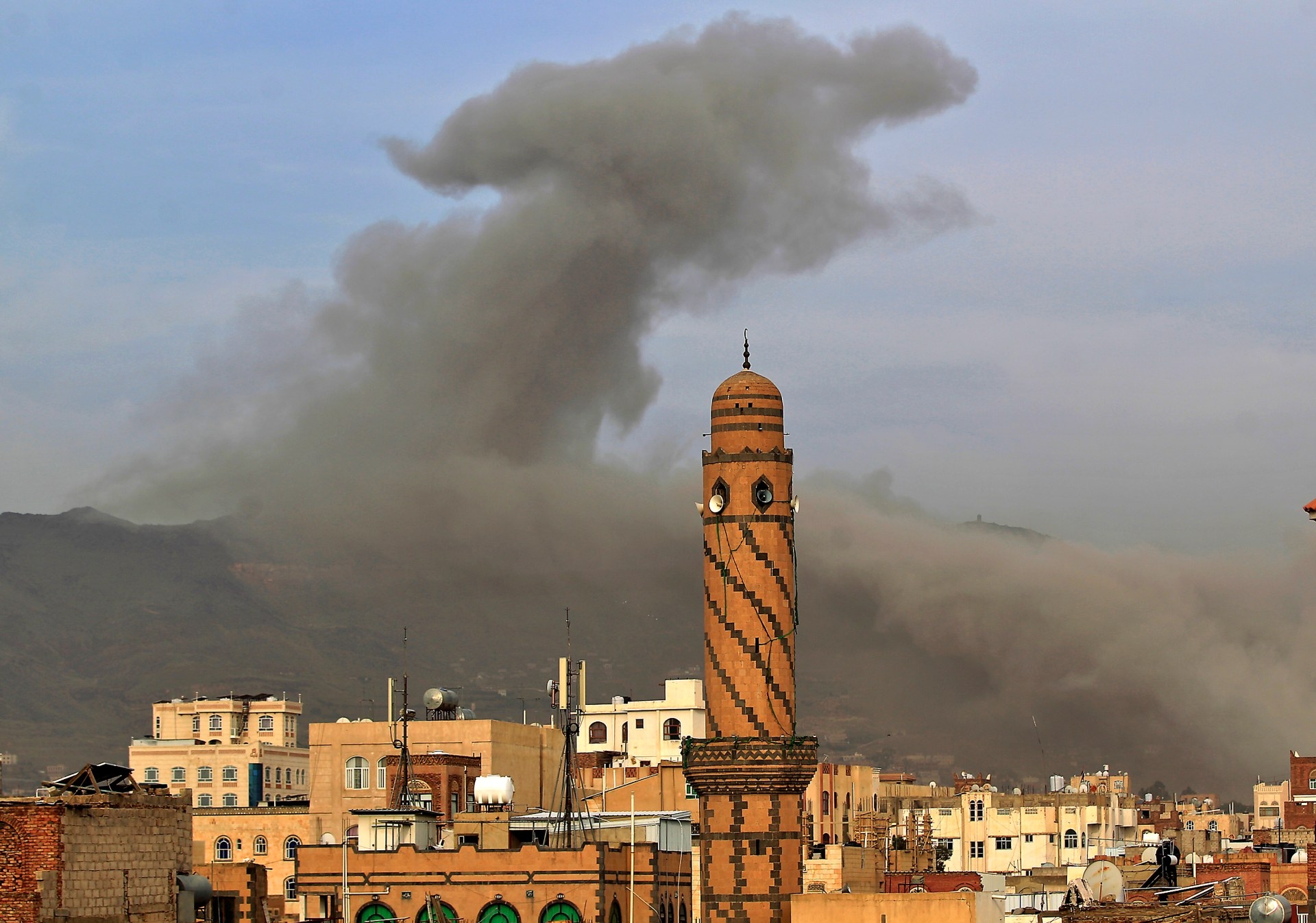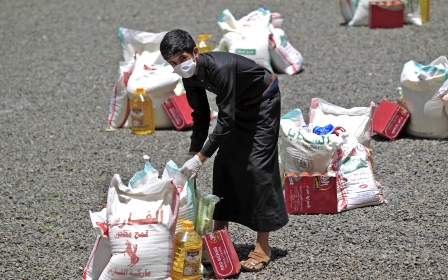Sanaa shakes as Yemeni capital struck by heaviest air strikes in years

It was around 6:45am (03.45 GMT) on Tuesday morning when Hussein al-Samie’s son began crying, woken by an earth-shattering air strike that targeted al-Nahdain Mountain in the middle of Sanaa.
Samie’s son, Shadi, is four years old. He has no memory of the relentless air strikes that pounded the Houthi-held capital in 2015 and 2016 when the Saudi-led coalition first entered Yemen’s war.
'It has been a long time since such air strikes targeted Sanaa, so not only children but even adults were terrified'
- Samie, Sanaa resident
Tuesday’s raid shook Samie’s house to its core, and with no experience of blasts this heavy and this close, Shadi’s nerves have been frayed as well.
“There were fiercer air strikes in 2015, but we adapted to the bombing then,” Samie told Middle East Eye. “It has been a long time since such air strikes targeted Sanaa, so not only children but even adults were terrified.”
Coalition warplanes have been hovering over Sanaa and other provinces almost constantly since Monday morning, and have targeted several areas around the capital such as al-Nahdain Mountain, Attan Mountain and the Aviation College.
New MEE newsletter: Jerusalem Dispatch
Sign up to get the latest insights and analysis on Israel-Palestine, alongside Turkey Unpacked and other MEE newsletters
A hardly observed coronavirus ceasefire expired last month, but Samie has nonetheless been shocked to see the return of heavy bombing.
“We heard about the ceasefire two months ago, and before that the air strikes stopped heavily targeting Sanaa, so I thought the war was moving towards the end,” he said.
“But now I believe that war won’t end, as I can see air strikes are targeting Sanaa again.”
Samie’s house is near al-Nahdain, and back in 2015 the air strikes targeted the area so heavily he was forced to flee.
“I rented a home in another area, but two years ago I returned after the fierce air strikes stopped and they became only a rarity,” he said.
“If the air strikes continue in the coming days, I will flee my home again to a safe neighbourhood.”
Yemen’s war has cost an estimated 100,000 lives in fighting, and thousands more deaths caused by malnutrition, disease and the collapse of health services.
Escalation in violence
According to the coalition, the recent fire has not been one-way traffic.
On Tuesday it said its forces destroyed a ballistic missile fired by the Houthis towards southern Saudi Arabia. The coalition also said it intercepted several drones launched on Monday night.
On Thursday, the Houthis’ Al-Masirah TV Channel said 77 air strikes had targeted several provinces in Yemen in 24 hours, including Sanaa, Saada, Amran, al-Beidha, Hajjah, Marib and al-Jawf.
One of those hit a vehicle in Saada province on Monday, killing 13 civilians including four children, sparking international condemnation.
'The battles are so far from the city, so why should we suffer under these strikes?'
- Saeed al-Zubairi, Sanaa
The attack happened the same day as the coalition, which is primarily made up of Saudi and UAE forces, was removed from the UN’s Children and Armed Conflict report’s blacklist for the first time in three years.
Muhsin Siddiquey, Oxfam’s Yemen country director, said: “We condemn all violence by all parties to the conflict. What the people of Yemen need now more than ever is a nationwide ceasefire and a return to negotiations between the warring parties.”
So far no civilians have been killed by the new wave of air strikes in Sanaa, but they are terrifying nonetheless and have broadcast a message to the city’s residents that an end to the war is nowhere in sight.
“Warplanes are hovering over us most of the day and night, and we hear bombings here and there. This terrorises civilians, including me,” Sanaa resident Saeed al-Zubairi, 48, told MEE.
“This isn’t the first time that Sanaa has seen air strikes shake its houses, but it came after a glimmer of hope for peace was opened.”
For Zubairi and other Sanaa residents, the reasons why the coalition has begun heavily striking the city remain a mystery.
“I need to know why those air strikes are targeting Sanaa. The battles are so far from the city, so why should we suffer under these strikes?” he asked.
“The Saudis’ pretext is there are weapon stores in Sanaa, but I don’t think the Houthis are stupid enough to hide the weapons in a residential city.”
Zubairi is resigned to the fighting ongoing, but he wishes clashes and bombardment would take place far from civilians’ homes.
“I’m not so silly I believe that the warring parties will end the conflict peacefully, as both don’t want to give up,” he said.
Yemenis who are supportive of the coalition acknowledge the terror and occasional civilian casualties from air strikes, but believe they are a necessary and important method of warfare against the Houthis.
“The Saudi-led coalition announced a ceasefire in April but the Houthis didn’t adhere to it, and they continued to target civilians and Saudi Arabia with their missiles,” Aden resident Ahmed told MEE.
“This time the air strikes came as a reaction to the Houthis’ targeting of Saudi territory, and the coalition depends on their sources to get correct information before targeting any area.”
Ahmed lauded the warplanes’ role in destroying Houthi weapons over the course of the war, and said they have stopped the movement from advancing.
Houthis condemn UN
A Houthi source in Sanaa told MEE that the United Nations had blood on its hands, because only once Saudi Arabia had been taken off its blacklist did the heavy strikes on the city resume.
“We can’t forget the aggression’s [coalition] crimes everywhere and what happened in Saada on Monday is only one of them,” he said, speaking on condition of anonymity.
“There are dozens of air strikes everyday nowadays, and this escalation came when the UN’s Children and Armed Conflict report removed the aggression from the report’s blacklist.”
According to the report, the coalition killed or wounded 222 children in Yemen last year. In total, all parties to the conflict were responsible for 689 such casualties last year.
Mohammed Abdulsalam, a Houthi spokesman, condemned the UN for removing Riyadh from the blacklist, accusing it of being “an accomplice with the killer”.
According to the Houthi source, the United Nations knows all too well the pain that the coalition has inflicted on children, and “there is no reason that the UN should remove the aggression from the list of shame”.
“The United Nations secretary-general is now responsible for any crime against Yemeni children,” he said.
Middle East Eye delivers independent and unrivalled coverage and analysis of the Middle East, North Africa and beyond. To learn more about republishing this content and the associated fees, please fill out this form. More about MEE can be found here.





